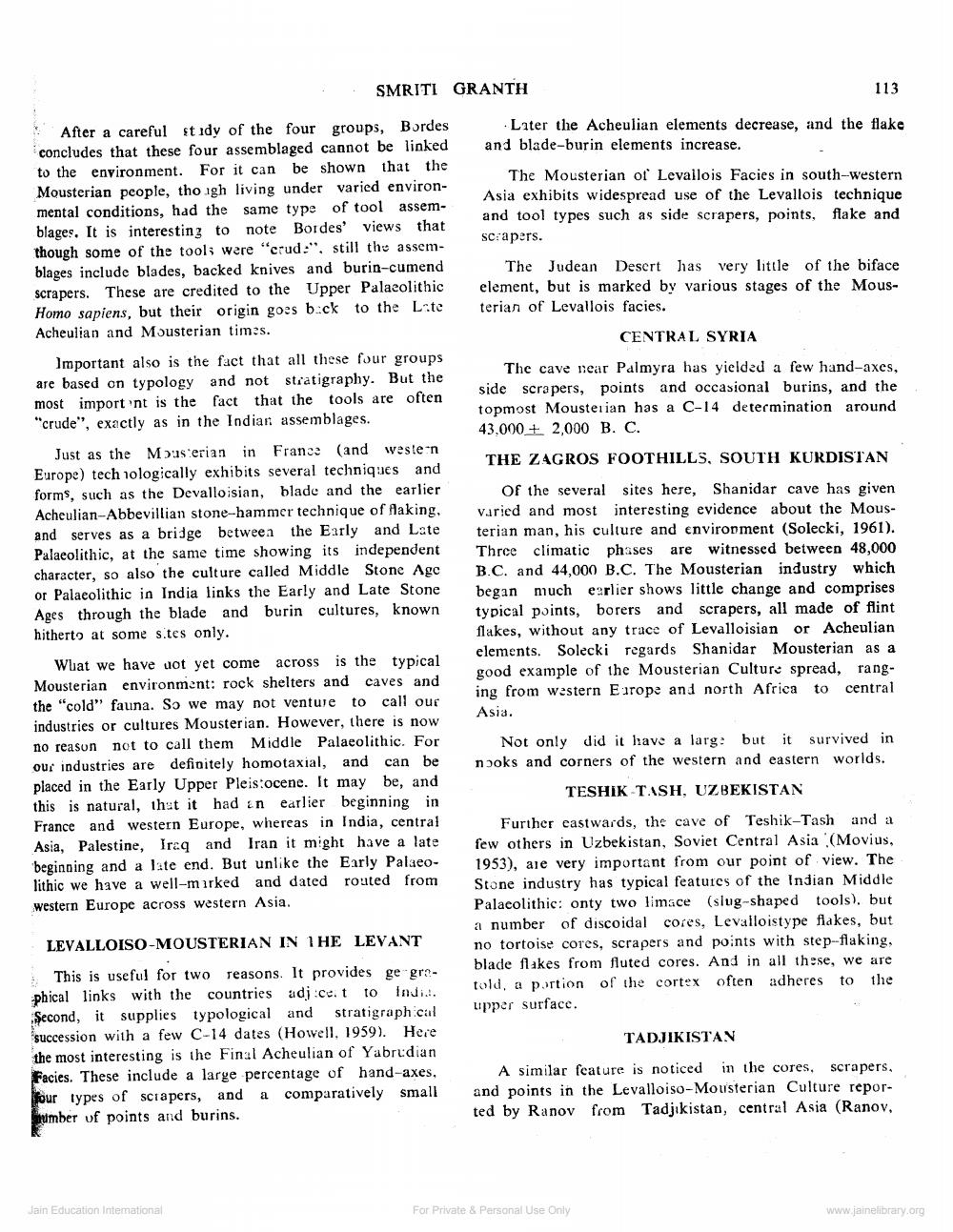________________
SMRITI GRANTH
113
After a careful tidy of the four groups, Bordes concludes that these four assemblaged cannot be linked to the environment. For it can be shown that the Mousterian people, thoigh living under varied environmental conditions, had the same type of tool assemblages. It is interesting to note Bordes' views that though some of the tools were "crud:", still the assemblages include blades, backed knives and burin-cumend scrapers. These are credited to the Upper Palaeolithic Homo sapiens, but their origin goes buck to the Lite Acheulian and Mousterian timss.
Later the Acheulian elements decrease, and the flake and blade-burin elements increase.
The Mousterian of Levallois Facies in south-western Asia exhibits widespread use of the Levallois technique and tool types such as side scrapers, points, flake and Sc:apers.
The Judean Desert has very little of the biface element, but is marked by various stages of the Mousterian of Levallois facies.
CENTRAL SYRIA
Important also is the fact that all these four groups are based on typology and not stratigraphy. But the most import nt is the fact that the tools are often "crude", exactly as in the Indian assemblages.
Just as the M asterian in France (and western Europe) technologically exhibits several techniques and forms, such as the Devalloisian, blade and the earlier Acheulian-Abbevillian stone-hammer technique of Making, and serves as a bridge between the Early and Late Palaeolithic, at the same time showing its independent character, so also the culture called Middle Stone Age or Palaeolithic in India links the Early and Late Stone Ages through the blade and burin cultures, known hitherto at some sites only.
What we have uot yet come across is the typical Mousterian environment: rock shelters and caves and the "cold" fauna. So we may not venture to call our industries or cultures Mousterian. However, there is now no reason not to call them Middle Palaeolithic. For our industries are definitely homotaxial, and can be placed in the Early Upper Pleistocene. It may be, and this is natural, that it had an earlier beginning in France and western Europe, whereas in India, central Asia, Palestine, Iraq and Iran it might have a late beginning and a late end. But unlike the Early Palaeolithic we have a well-marked and dated routed from western Europe across western Asia.
The cave near Palmyra has yielded a few hand-axes, side scrapers, points and occasional burins, and the topmost Mousterian has a C-14 determination around 43.000+ 2,000 B. C. THE ZAGROS FOOTHILLS, SOUTH KURDISTAN
of the several sites here, Shanidar cave has given varied and most interesting evidence about the Mousterian man, his culture and environment (Solecki, 1961). Three climatic phases are witnessed between 48,000 B.C. and 44,000 B.C. The Mousterian industry which began much earlier shows little change and comprises typical points, borers and scrapers, all made of flint flakes, without any trace of Levalloisian or Acheulian elements. Solecki regards Shanidar Mousterian as a good example of the Mousterian Culture spread, ranging from western Europe and north Africa to central Asia.
Not only did it have a larg. but it survived in nooks and corners of the western and eastern worlds.
TESHIK TASH, UZBEKISTAN
Further castwards, the cave of Teshik-Tash and a few others in Uzbekistan, Soviet Central Asia (Movius, 1953), are very important from our point of view. The Stone industry has typical features of the Indian Middle Palacolithic: onty two limace (slug-shaped tools), but a number of discoidal cores, Levalloistype flakes, but no tortoise cores, scrapers and points with step-flaking, blade fakes from futed cores. And in all these, we are told, a portion of the cortex often adheres to the upper surface.
LEVALLOISO-MOUSTERIAN IN THE LEVANT
This is useful for two reasons. It provides ge graphical links with the countries adj.cet to indi.. Second, it supplies typological and stratigraphical succession with a few C-14 dates (Howell, 1959). Here the most interesting is the Final Acheulian of Yabrudian Facies. These include a large percentage of hand-axes, four types of sciapers, and a comparatively small Thumber of points and burins.
TADJIKISTAN
A similar feature is noticed in the cores, scrapers, and points in the Levalloiso-Mousterian Culture reported by Ranov from Tadjikistan, central Asia (Ranov,
Jain Education Intemational
For Private & Personal Use Only
www.jainelibrary.org




